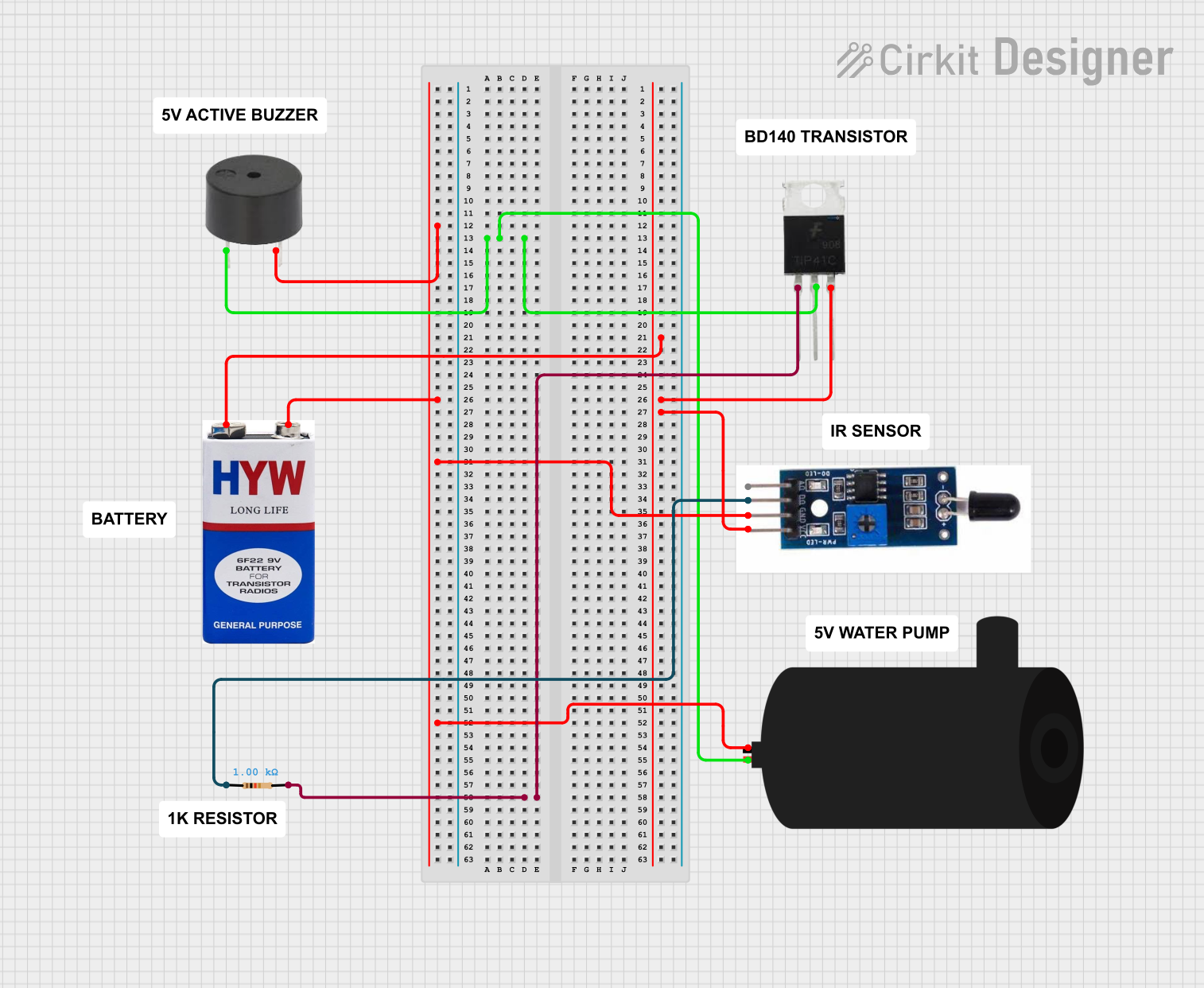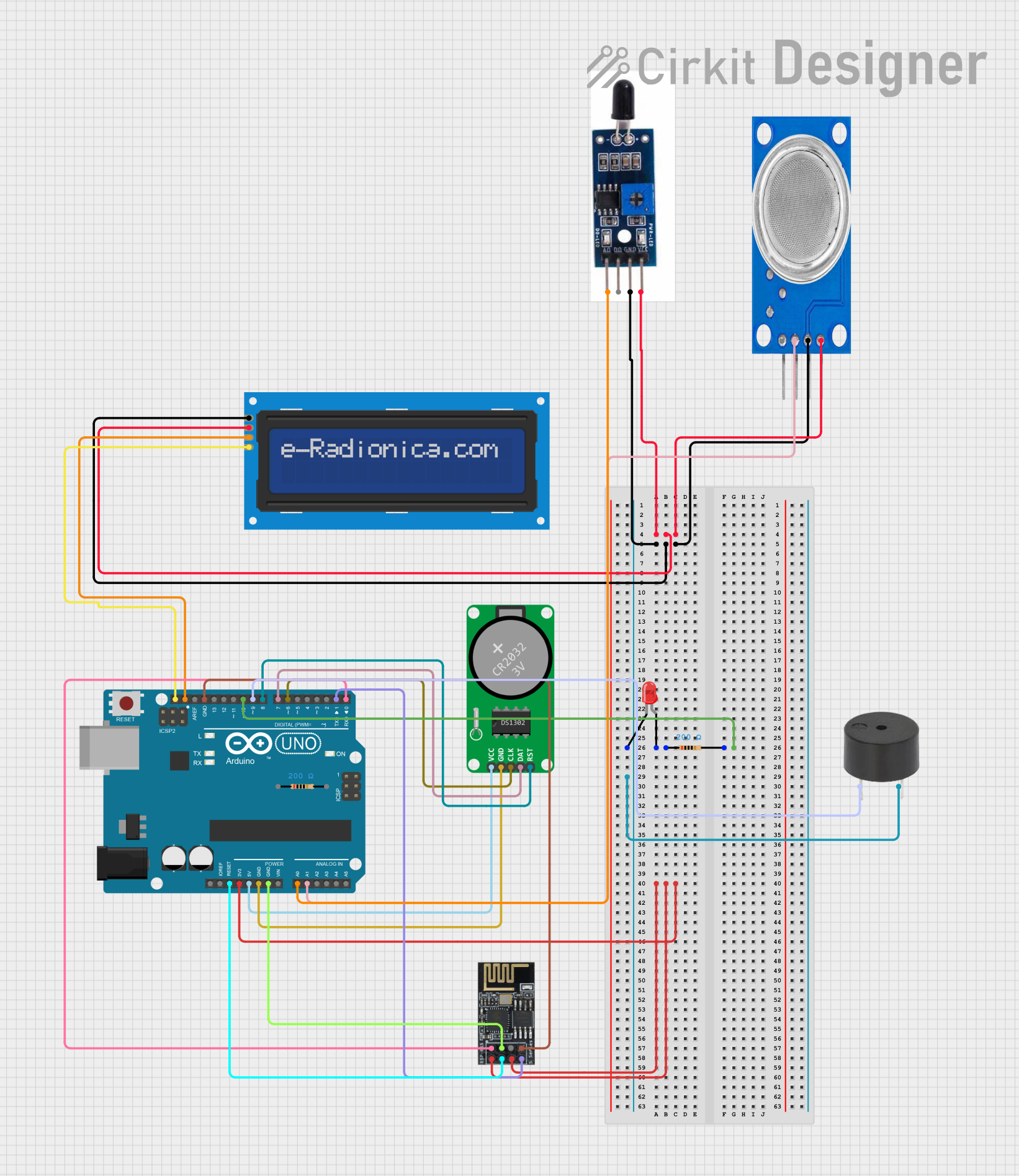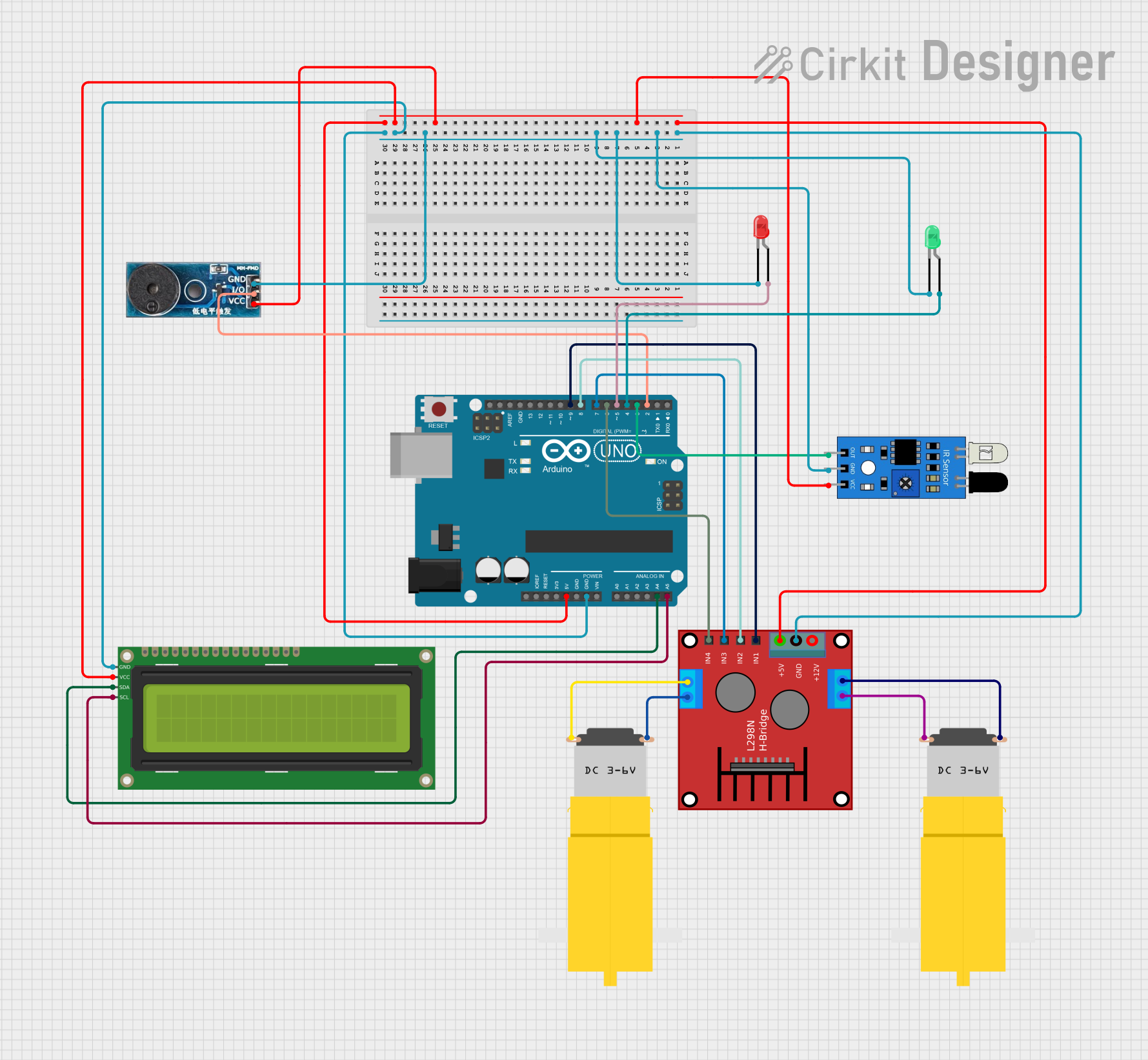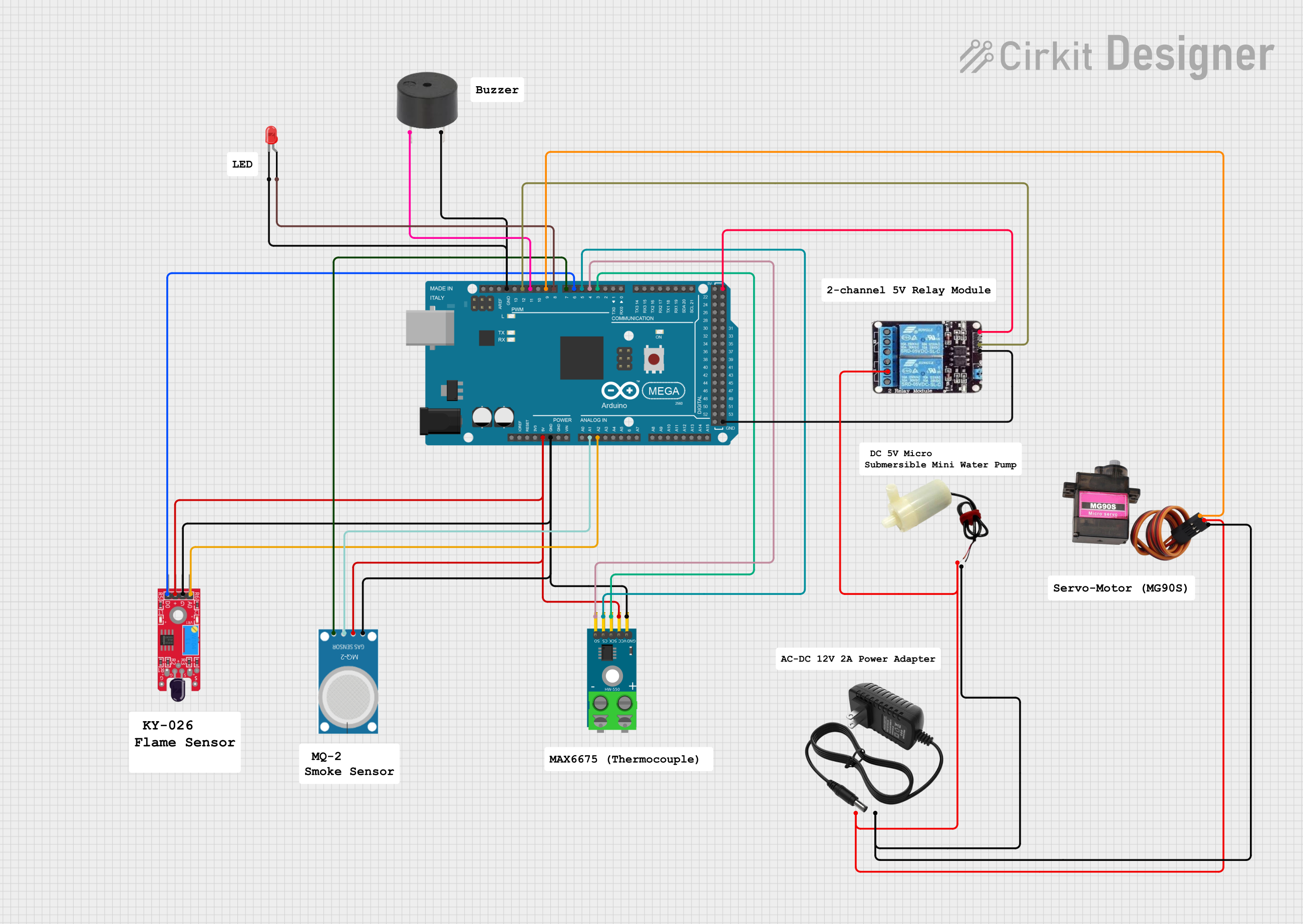
Cirkit Designer
Your all-in-one circuit design IDE
Home /
Component Documentation
How to Use FLAME SENSOR : Examples, Pinouts, and Specs

 Design with FLAME SENSOR in Cirkit Designer
Design with FLAME SENSOR in Cirkit DesignerIntroduction
The Flame Sensor, manufactured by Arduino (Part ID: ARDUINO), is a device designed to detect the presence of a flame or fire. It is commonly used in safety applications to ensure that a flame is present in heating systems, thereby preventing gas leaks and potential explosions. This sensor is highly sensitive to flame and infrared light, making it an essential component in various safety and automation systems.
Explore Projects Built with FLAME SENSOR
Flame Detection and Automatic Water Pump Activation System

This circuit features a heat flame sensor that likely triggers a response when detecting heat or flame. The sensor's digital output (DO) is connected through a resistor to a TIP41C transistor, which acts as a switch for a buzzer and a water pump, indicating that the circuit is designed to sound an alarm and possibly activate a water pump in the event of detecting a flame. The 9V battery powers the circuit, and all components share a common ground.
 Open Project in Cirkit Designer
Open Project in Cirkit DesignerArduino UNO-Based Environmental Monitoring System with Wi-Fi Connectivity

This circuit is designed to monitor environmental conditions using a heat flame sensor and an MQ135 air quality sensor, display information on an LCD screen, and maintain accurate time with an RTC module. It includes an ESP8266 Wi-Fi module for potential wireless connectivity and uses a buzzer and LED for alerts or status indications. The Arduino UNO serves as the central controller, though the specific embedded code for operation is not yet provided.
 Open Project in Cirkit Designer
Open Project in Cirkit DesignerArduino UNO Flame Detection Robot with LCD Display and Buzzer Alert

This circuit is a flame detection and response system using an Arduino UNO. It includes an IR sensor to detect flames, which triggers motors, LEDs, a buzzer, and an LCD display to indicate the presence of a flame. The system activates motors and a red LED, sounds the buzzer, and displays a warning message on the LCD when a flame is detected, otherwise, it shows a safe status with a green LED.
 Open Project in Cirkit Designer
Open Project in Cirkit DesignerArduino Mega 2560-Based Fire and Gas Detection System with Automated Water Pump

This circuit is a sensor-based monitoring and control system using an Arduino Mega 2560. It integrates a flame sensor, gas sensor, temperature sensor, and various output devices such as an LED, buzzer, servo motor, and water pump, controlled via a relay. The system is designed to detect environmental conditions and respond accordingly, potentially for safety or automation purposes.
 Open Project in Cirkit Designer
Open Project in Cirkit DesignerExplore Projects Built with FLAME SENSOR

Flame Detection and Automatic Water Pump Activation System
This circuit features a heat flame sensor that likely triggers a response when detecting heat or flame. The sensor's digital output (DO) is connected through a resistor to a TIP41C transistor, which acts as a switch for a buzzer and a water pump, indicating that the circuit is designed to sound an alarm and possibly activate a water pump in the event of detecting a flame. The 9V battery powers the circuit, and all components share a common ground.
 Open Project in Cirkit Designer
Open Project in Cirkit Designer
Arduino UNO-Based Environmental Monitoring System with Wi-Fi Connectivity
This circuit is designed to monitor environmental conditions using a heat flame sensor and an MQ135 air quality sensor, display information on an LCD screen, and maintain accurate time with an RTC module. It includes an ESP8266 Wi-Fi module for potential wireless connectivity and uses a buzzer and LED for alerts or status indications. The Arduino UNO serves as the central controller, though the specific embedded code for operation is not yet provided.
 Open Project in Cirkit Designer
Open Project in Cirkit Designer
Arduino UNO Flame Detection Robot with LCD Display and Buzzer Alert
This circuit is a flame detection and response system using an Arduino UNO. It includes an IR sensor to detect flames, which triggers motors, LEDs, a buzzer, and an LCD display to indicate the presence of a flame. The system activates motors and a red LED, sounds the buzzer, and displays a warning message on the LCD when a flame is detected, otherwise, it shows a safe status with a green LED.
 Open Project in Cirkit Designer
Open Project in Cirkit Designer
Arduino Mega 2560-Based Fire and Gas Detection System with Automated Water Pump
This circuit is a sensor-based monitoring and control system using an Arduino Mega 2560. It integrates a flame sensor, gas sensor, temperature sensor, and various output devices such as an LED, buzzer, servo motor, and water pump, controlled via a relay. The system is designed to detect environmental conditions and respond accordingly, potentially for safety or automation purposes.
 Open Project in Cirkit Designer
Open Project in Cirkit DesignerCommon Applications and Use Cases
- Heating Systems: Ensures the presence of a flame to prevent gas leaks.
- Fire Alarms: Detects fire and triggers alarms for safety.
- Robotics: Used in fire-fighting robots to locate and extinguish flames.
- Industrial Safety: Monitors industrial processes to prevent fire hazards.
Technical Specifications
Key Technical Details
| Parameter | Value |
|---|---|
| Operating Voltage | 3.3V to 5V |
| Operating Current | 20mA |
| Detection Range | 760 nm to 1100 nm (IR light) |
| Detection Angle | 60 degrees |
| Output Type | Digital and Analog |
| Response Time | 15 microseconds |
| Operating Temperature | -25°C to 85°C |
Pin Configuration and Descriptions
| Pin Number | Pin Name | Description |
|---|---|---|
| 1 | VCC | Power supply (3.3V to 5V) |
| 2 | GND | Ground |
| 3 | A0 | Analog output (proportional to flame intensity) |
| 4 | D0 | Digital output (HIGH when flame is detected) |
Usage Instructions
How to Use the Component in a Circuit
- Power Supply: Connect the VCC pin to a 3.3V or 5V power supply and the GND pin to the ground.
- Analog Output: Connect the A0 pin to an analog input pin on your microcontroller to read the flame intensity.
- Digital Output: Connect the D0 pin to a digital input pin on your microcontroller to detect the presence of a flame.
Important Considerations and Best Practices
- Placement: Ensure the sensor is placed in a location where it has a clear line of sight to the potential flame source.
- Calibration: Calibrate the sensor to adjust its sensitivity according to your specific application.
- Shielding: Protect the sensor from direct sunlight and other strong light sources to avoid false positives.
- Testing: Regularly test the sensor to ensure it is functioning correctly.
Example Code for Arduino UNO
// Flame Sensor Example Code for Arduino UNO
const int flameSensorPin = A0; // Analog pin connected to A0 of the sensor
const int digitalPin = 2; // Digital pin connected to D0 of the sensor
int flameAnalogValue = 0; // Variable to store the analog value
void setup() {
pinMode(digitalPin, INPUT); // Set digital pin as input
Serial.begin(9600); // Initialize serial communication
}
void loop() {
flameAnalogValue = analogRead(flameSensorPin); // Read analog value
int flameDigitalValue = digitalRead(digitalPin); // Read digital value
// Print the analog value to the Serial Monitor
Serial.print("Analog Value: ");
Serial.println(flameAnalogValue);
// Check if flame is detected
if (flameDigitalValue == HIGH) {
Serial.println("Flame detected!");
} else {
Serial.println("No flame detected.");
}
delay(500); // Wait for 500 milliseconds before next reading
}
Troubleshooting and FAQs
Common Issues Users Might Face
False Positives:
- Cause: Strong light sources or reflections.
- Solution: Shield the sensor from direct sunlight and other strong light sources.
No Detection:
- Cause: Incorrect placement or wiring.
- Solution: Ensure the sensor has a clear line of sight to the flame and check all connections.
Inconsistent Readings:
- Cause: Electrical noise or interference.
- Solution: Use proper grounding and shielding techniques to minimize interference.
Solutions and Tips for Troubleshooting
- Check Connections: Ensure all connections are secure and correct.
- Calibrate Sensor: Adjust the sensitivity of the sensor to suit your application.
- Test Regularly: Perform regular tests to ensure the sensor is functioning correctly.
- Use Serial Monitor: Utilize the Serial Monitor in Arduino IDE to debug and monitor sensor readings.
By following this documentation, users can effectively integrate the Flame Sensor into their projects, ensuring reliable flame detection and enhancing safety measures.